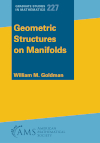- About MAA
- Membership
- MAA Publications
- Periodicals
- Blogs
- MAA Book Series
- MAA Press (an imprint of the AMS)
- MAA Notes
- MAA Reviews
- Mathematical Communication
- Information for Libraries
- Author Resources
- Advertise with MAA
- Meetings
- Competitions
- Programs
- Communities
- MAA Sections
- SIGMAA
- MAA Connect
- Students
- MAA Awards
- Awards Booklets
- Writing Awards
- Teaching Awards
- Service Awards
- Research Awards
- Lecture Awards
- Putnam Competition Individual and Team Winners
- D. E. Shaw Group AMC 8 Awards & Certificates
- Maryam Mirzakhani AMC 10 A Awards & Certificates
- Two Sigma AMC 10 B Awards & Certificates
- Jane Street AMC 12 A Awards & Certificates
- Akamai AMC 12 B Awards & Certificates
- High School Teachers
- News
You are here
Geometric Structures on Manifolds

Buy Now:
Publisher:
AMS
Publication Date:
2022
Number of Pages:
409
Format:
Paperback
Series:
Graduate Studies in Mathematics
Price:
85.00
ISBN:
978-1470471989
Category:
Monograph
[Reviewed by , on ]
Max Lahn
12/30/2023
Geometric Structures on Manifolds is an accessible, sophisticated, modern, and grounded introduction to the theory of (G,X)-structures on manifolds, which standardize the notion of spaces locally modeled on manifolds with geometry, aimed at a graduate level audience and above. Themselves modeled after the atlas definition of a differentiable manifold, (G,X)-structures consist of atlases of charts valued in the model space X, with transition maps which are locally elements of the (pseudo-)group G (which acts real-analytically on X). Examples abound, and include projective structures, Euclidean structures, hyperbolic structures, affine structures, and more.
is divided into three parts. In Part 1, the author introduces the model geometries of which many of the relevant examples mentioned above are refinements. Affine, projective, and hyperbolic geometries are introduced with a blend of concrete and synthetic points of view, and several of the basic geometric notions are defined and verified. The author ends with a study of convexity and the Hilbert metric; the key results here are Vey's semisimplicity theorem and Benzécri's compactness theorem.
In Part 2, the author develops the general theory of (G,X)-structures, both introducing basic notions such as the developing map, holonomy, completeness, and the developing section as well as posing key questions such as that of classifying equivalence classes of marked (G,X)-structures. Part 2 ends some initial classification results, namely Bieberbach's theorems on closed Euclidean manifolds and the classification due to Nagano--Yagi and Arrowsmith--Furness of complete affine structures on the 2-dimensional torus.
Finally, Part 3 is dedicated to exploring the properties and classification of affine and projective structures on manifolds, with an initial focus on surfaces. Of all the parts of "Geometric Structures on Manifolds", this part is the least linearly developed; most chapters are independent (although they certainly rely on previous material from Parts 1 and 2), and they can mostly be read in any order. Of particular interest is Chapter 12, which deals with Kobayashi hyperbolicity.
Geometric Structures on Manifolds would make an excellent reference text upon which to base a semester-long intermediate level graduate course. Such a course would need to assume at least a semester in differential topology as well as some differential geometry and algebraic topology (at least enough to assume familiarity with the fundamental groups of manifolds). It seems likely to the reviewer that an instructor of such a course would have to omit significant pieces of Part 3 for reasons of time, although spending time working through some of the well-explained appendices may be useful for courses with less developed background. Such an instructor should also take care in choosing exercises from the book, since some exercises infrequently rely on material not yet covered.
Max Lahn is a graduate student at the University of Michigan. Their areas of interest include higher Teichmüller theory and length spectra of hyperbolic surfaces.
See the publisher's website.
- Log in to post comments




